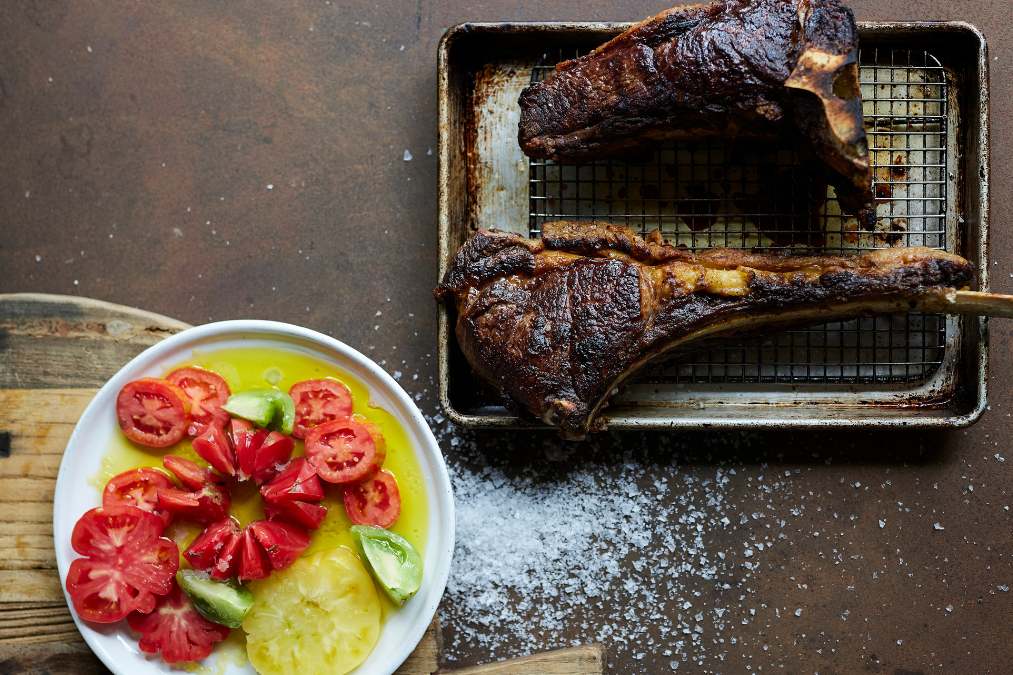Ageing Gracefully: The Unexpected Journey of Retired Dairy Cows into Fine Dining
Under Esther’s hanging artworks of intrigue, diners will come across a new addition to the menu at Esther, Retired Dairy Cow. Now, we appreciate that ‘retired’ doesn’t exactly have a compelling ring, but once you understand the story behind this new experience, perhaps you’ll be captivated to try this for yourself. Trust us and the chef, we’re right to make a fuss about it. First tried and tested in an intimate dinner at Esther, Chef Sean sat around the table with the likes Kelli Brett of Cuisine, Kerry Tyack, Simon Erickson from Neat Meat, alongside butcher and farmer, Grant Bennet. He eagerly awaited their honest feedback on the meat of once New Zealand dairy cattle, for Sean, serving this offering has been 10 years in the making.
The verdict? Outstanding.
Retired Dairy Cow is exactly that. Jersey cows which have produced thousands of litres of milk and calves over their lifetime, and their life’s work rewarded with a proper retirement. These dairy cows are fed on lush green pastures of the far North for the remainder of the lives and finished as a premium meal instead ground down for mince and pet food.
Eating dairy cow has been a common practice in Europe for centuries, firmly entrenched in the Basque region of Spain where many Michelin-starred restaurants serve it as a regular option. Sean could never understand why we wouldn’t be doing the same here in New Zealand – a country that houses more dairy cows than people. “There seems to be a stigma that old cows are cheap and tough,” says Sean who is determined to break down these barriers one meal at a time.

Teaming up with Simon Erikson of Neat Meat and Grant Bennett of Speckle Park Cattle, the trio wanted to bring older meat to the table to educate diners and have them appreciate the full potential of a diary cow’s life. Simon says, “New Zealand dairy farmers are among the most efficient dairy producers in the world, right? That is their core focus. But they don’t pay much attention to finishing the cow, to making it even more useful.”
Initial questions raised by Sean on how diners would react to being offered meat from an older, retired milker as an alternative to highly marbled grass-fed prime beef cattle, or how could they be sure a dairy cow carcass would deliver enough meat to cover production costs. This is where Grant came into the fold. Speckle Park is a farm in the Tuatara Ranges with cattle which are premium beef in their own right, recognised for their high marbling genetics.
The Retired Dairy Cow found on Esther’s menu comes from Speckle Park and have a much more gracious ending than most of their peers. They are sent off to a ‘meat retreat’, in a paddock to themselves with the best feed available. Generally, with beef the meat is ready once the cow is fully grown but given these cattle have been fully grown for some time, all the extra feed goes into their conditioning where the marbling matures, and they develop layers of buttery, gold fat.
Not only is this a story of honoring the efforts of dairy cows, it’s also one of sustainability. “Twenty years ago, waiters would explain where every ingredient of each meal was sourced to highlight the locality. Now, it’s a given that everything is well-sourced, have minimal mileage and come from ethical practices. Food must have integrity. Authenticity is key for 2023 and this can be seen in our sustainability practices. A different way to be more sustainable is the harvesting of dairy cows who typically end their careers as that” says Sean.
Going beyond knowing where ingredients come from, Simon and Eric can tell the tale of each dairy cow that comes through the kitchen at Esther. Esther’s first dairy cow #424, is calculated to have walked more than 11,000km over the course of her life and by the end of her career, had delivered around 4,200 liters of milk per year, as well as 390kg of milk solids annually. She has had 10 live calves equating to 300kg carcass weight going back into the meat industry each year.
“This is an idea that has left me so excited. I’ve lived the life of three men, been round the world and back and rarely do I get excited about anything these days but to able to celebrate these amazing animals and what they’ve given to New Zealand, celebrating their life with a feast for my family and friends has left me buzzing,” says Sean.
Whilst Sean, Simon and Grant are still in the experimental stages, their first harvest was a success and believe there but there is still more in it. Longer time in pasture and a longer hanging time could deliver an even more premium product. Sean and Executive Chef at Esther, James Laird, are making regular adjustments to the cuts and the ageing process, which they deem crucial to achieving that high-flavour, high-satisfaction product that chefs and diners look for. As they’re cooking with fire, the grass-fed beef is elevated further with the Neanderthal technique of barbequing.
Now all that’s left is helping people to overcome entrenched mind-sets and tempt them into Esther to try this incredible innovation, a New Zealand first.
So, curious? See you at Esther.
